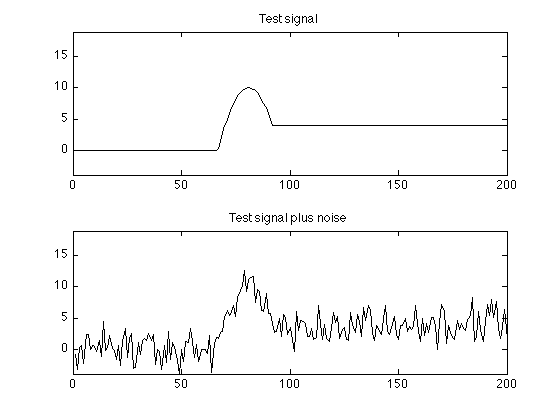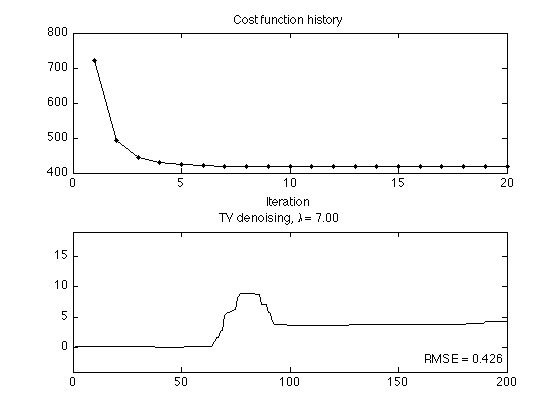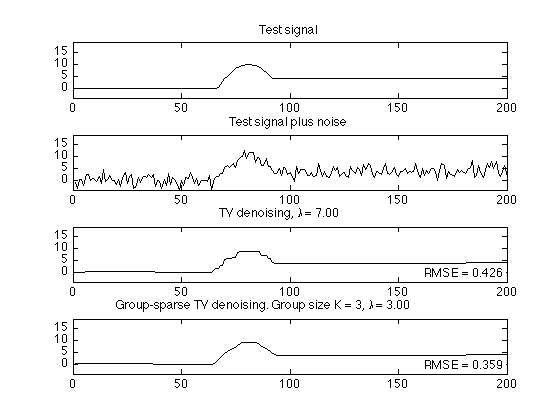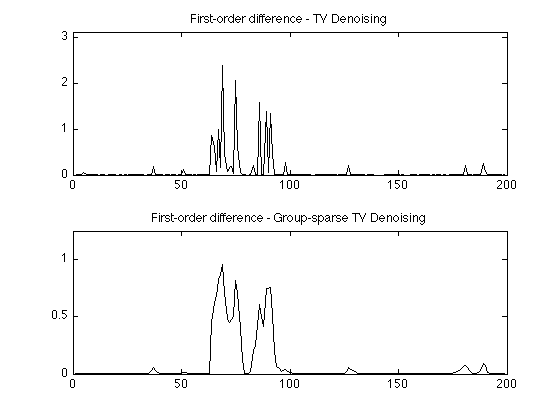Group-Sparse Total-Variation Denoising (GS-TVD) : Example 1
Comparison of TV denoising and group-sparse TV denoising. The test signal consists of a pulse.
Ivan Selesnick, selesi@poly.edu, 2012
Contents
Start
clear close all printme = @(filename) print('-dpdf', sprintf('figures/Example1_%s', filename)); set(0,'DefaultAxesColorOrder', [1 1 1]*0); % make all plot lines black
Make test signal
N = 200; % N : signal length n = 0:N-1; s = max( 4*(n > 80), 10 - 0.05*(n-80).^2); s = 10*s/max(s); s = s(:); % s : noise-free signal randn('state',0); % Set state so that example is reproducible noise = 2.0*randn(size(s)); % zero-mean Gaussian noise y = s + noise; % y : signal plus noise % Display noise-free signal, s figure(1) clf subplot(2,1,1) plot(s) ax1 = [0 N -4 19]; axis(ax1) title('Test signal'); % Display noisey signal, y subplot(2,1,2) plot(y) axis(ax1) title('Test signal plus noise'); printme('input')

TV Denoising (TVD)
Perform total-variation denoising
lam1 = 7; % lam1 : regularization parameter Nit = 20; % Nit : number of iterations [x1, cost] = tvd(y, lam1, Nit); % TV denoising algorithm txt1 = sprintf('TV denoising, \\lambda = %.2f', lam1); rmse_tv = sqrt( mean( (s - x1).^2 ) ) txt_rmse_tv = sprintf('RMSE = %.3f', rmse_tv); % Display cost function to verify convergence figure(2) clf subplot(2,1,1) plot(1:Nit, cost, '.-') title('Cost function history'); xlabel('Iteration') % Display output of TV denoising subplot(2,1,2) plot(x1) axis(ax1) title(txt1); axnote(txt_rmse_tv) printme('TVD')
rmse_tv =
0.4263

Group-sparse TV Denoising (GS-TVD)
Perform group-spase total-variation denoising on the same noisy signal. The group size is K = 3.
K = 3; % K : group size lam = 3.0; % lam : regularlization parameter [xg, costg] = gstvd(y, K, lam, Nit); % GS-TVD algorithm txtg = sprintf('Group-sparse TV denoising. Group size K = %d, \\lambda = %.2f', K, lam); rmse_tvgs = sqrt( mean( (s - xg).^2 ) ) txt_rmse_tvgs = sprintf('RMSE = %.3f', rmse_tvgs); % Display cost function history to verify convergence figure(1) clf subplot(2,1,1) plot(costg,'.-') title('Cost function history'); xlabel('Iteration') ylim([300 900]) % Display output of GS-TVD subplot(2,1,2) plot(xg) axis(ax1) title(txtg); axnote(txt_rmse_tvgs) printme('GSTVD')
rmse_tvgs =
0.3589

Display signals
figure(10) clf subplot(4,1,1) plot(s) axis(ax1) title('Test signal'); subplot(4,1,2) plot(y) axis(ax1) title('Test signal plus noise'); subplot(4,1,3) plot(x1) % plot TVD output axis(ax1) title(txt1); axnote(txt_rmse_tv) subplot(4,1,4) plot(xg) % plot GS-TVD denoising output axis(ax1) title(txtg); axnote(txt_rmse_tvgs) orient tall printme('signals')

Show first-order difference
The first-order difference function of the output of TVD and GS-TVD emphasize the difference between the two denoising methods.
figure(1) clf subplot(2,1,1) plot(abs(diff(x1))) xlim([0 N]) ylim([0 1.3*max(abs(diff(x1)))]) title('First-order difference - TV Denoising'); subplot(2,1,2) plot(abs(diff(xg))) xlim([0 N]) ylim([0 1.3*max(abs(diff(xg)))]) title('First-order difference - Group-sparse TV Denoising'); printme('diff')

set(0,'DefaultAxesColorOrder', 'remove');